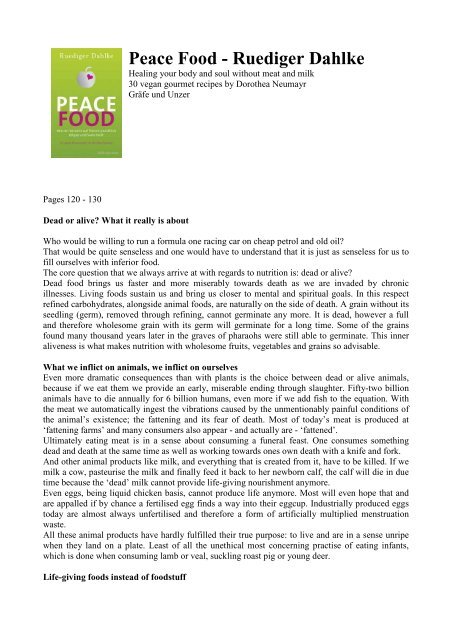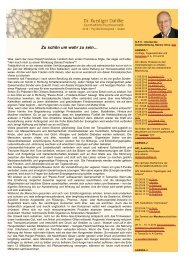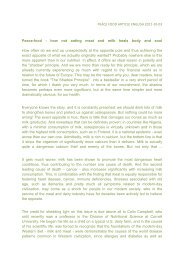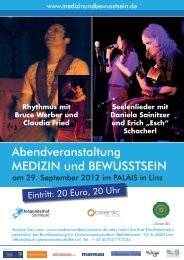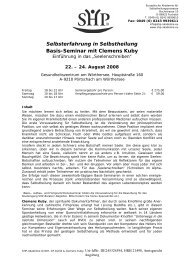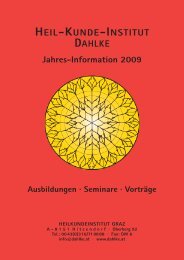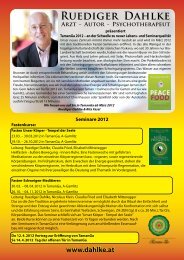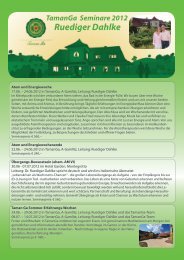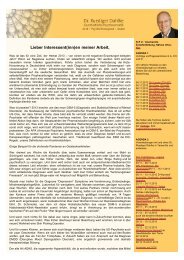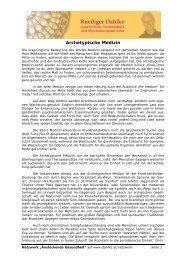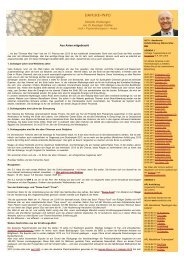Peace Foods_abstract-engl - Dr. Ruediger Dahlke
Peace Foods_abstract-engl - Dr. Ruediger Dahlke
Peace Foods_abstract-engl - Dr. Ruediger Dahlke
Create successful ePaper yourself
Turn your PDF publications into a flip-book with our unique Google optimized e-Paper software.
<strong>Peace</strong> Food - <strong>Ruediger</strong> <strong>Dahlke</strong>Healing your body and soul without meat and milk30 vegan gourmet recipes by Dorothea NeumayrGräfe und UnzerPages 120 - 130Dead or alive? What it really is aboutWho would be willing to run a formula one racing car on cheap petrol and old oil?That would be quite senseless and one would have to understand that it is just as senseless for us tofill ourselves with inferior food.The core question that we always arrive at with regards to nutrition is: dead or alive?Dead food brings us faster and more miserably towards death as we are invaded by chronicillnesses. Living foods sustain us and bring us closer to mental and spiritual goals. In this respectrefined carbohydrates, alongside animal foods, are naturally on the side of death. A grain without itsseedling (germ), removed through refining, cannot germinate any more. It is dead, however a fulland therefore wholesome grain with its germ will germinate for a long time. Some of the grainsfound many thousand years later in the graves of pharaohs were still able to germinate. This inneraliveness is what makes nutrition with wholesome fruits, vegetables and grains so advisable.What we inflict on animals, we inflict on ourselvesEven more dramatic consequences than with plants is the choice between dead or alive animals,because if we eat them we provide an early, miserable ending through slaughter. Fifty-two billionanimals have to die annually for 6 billion humans, even more if we add fish to the equation. Withthe meat we automatically ingest the vibrations caused by the unmentionably painful conditions ofthe animal’s existence; the fattening and its fear of death. Most of today’s meat is produced at‘fattening farms’ and many consumers also appear - and actually are - ‘fattened’.Ultimately eating meat is in a sense about consuming a funeral feast. One consumes somethingdead and death at the same time as well as working towards ones own death with a knife and fork.And other animal products like milk, and everything that is created from it, have to be killed. If wemilk a cow, pasteurise the milk and finally feed it back to her newborn calf, the calf will die in duetime because the ‘dead’ milk cannot provide life-giving nourishment anymore.Even eggs, being liquid chicken basis, cannot produce life anymore. Most will even hope that andare appalled if by chance a fertilised egg finds a way into their eggcup. Industrially produced eggstoday are almost always unfertilised and therefore a form of artificially multiplied menstruationwaste.All these animal products have hardly fulfilled their true purpose: to live and are in a sense unripewhen they land on a plate. Least of all the unethical most concerning practise of eating infants,which is done when consuming lamb or veal, suckling roast pig or young deer.Life-giving foods instead of foodstuff
We have to differentiate between dead food that allows us to survive and life-giving food thatimparts life because it contains and transmits living light and also the information of life.Humans don’t live off bread alone but also ingest the energy, vibrations and fields that are attachedto it. This is something we are not conscious enough of in our modern world and when scientificstudies confirm what finely tuned humans can already sense, it will be time to rejoice.In an ashram – a meditation centre - in which I was fortunate enough to be a guest in a few yearsago, only advanced students of the master were allowed to lend a hand in the kitchen with foodpreparation. The act of cooking and the thoughts that are released while doing so were of utmostimportance to him. He also taught us that the thoughts we think during eating are just as importantas we also consume those. Silent consciousness is therefore an important component and ritual atmealtimes in some of these communities as it eases the ability to control thoughts. Even a shortreflection before a meal can be helpful. In earlier times saying grace before a meal may also haveprovided this positive side effect for us. But even today a short moment of respect for a meal maybe an effective possibility.A question of vibrationAfter all, with plant food it is also about vibrations we ingest. Insofar plant foods grown underacceptable, natural conditions are preferable to those produced industrially in greenhouses and withthe use of chemical fertilisers. There is a difference to the wholesomeness of a product if it has beengrown naturally, cooked and served with life-promoting thoughtfulness or whether it has beenproduced in a factory and then carelessly served and eaten. Everyone can sense that and wouldrather be served by a waiter who is caring and friendly than one who is sullen. Of course this is alsoa weighty argument for biological and ecologically grown products.Plant food is – with the exception of sprouts – best consumed when completely ripened and fall intoour laps as a present like ripe fruit. Even a soul, which is not conscious of these connections, cansense them and reacts to them obviously. In any case, I have known these experiences much longerthan those new studies have existed, but I am very thankful that they now show these connectionsindisputably for those truly scientifically orientated people.When wholesome foods prove to be superior with a view to avoiding deadly illnesses such ascancer and heart problems it is also because they transmit the whole value of the plant and thereforeare truly valuable.Animals from mass production are treated with all sorts of pharmaceuticals to stop the dying so thatthey can be killed mechanically, prematurely and inhumanely – they do not get to live, in the truesense. Such food can of course not promote life within us but only bring us death.From odour to scentsThe healthy human will emit the scent of the last fruit consumed, so the Indians say; one morereason to consume more edible plants. Meat eaters, in fact, do have an unpleasant odour that theirurine, faeces and sweat reveal. Self-urine therapy, for example, is unthinkable for them and also notvery sensible.The scent of flowering plants on the other hand is something positively familiar to us and is alsoused in the perfume industry. In the end, all plants flower at some stage and are therefore muchbetter suited to bring our true being into bloom.In fact, humans can smell pleasantly. People from Berlin are familiar with the term “dufte Typen”,which literally translates to “pleasantly-smelling human”. Many vegans come across this pleasantexperience and almost all will also have experienced a person they could not stand the smell of.This is due to what we fill ourselves with and finally emit.Herd mentality instead of individualitySince people of the western world, the so-called civilised world, are hanging on a cow’s udder byconsuming a variety of dairy products they also ingest more strongly the vibrations and the modernliving conditions of this herd animal. There is also no good scent of aliveness in this ingestion. Ifwe let modern pasteurised milk go off we will find that where once it would have turned intopleasantly tasting sour milk it now develops into a smelly substance not fit for consumption.
With milk and its by products, we ingest the vibrations of the cows. In the last couple of decadesthis also means from cows that are hornless and defenceless, often spending their life withoutseeing daylight, without ever eating fresh grass. How then will their milk and other dairy productsbe good for us? To ensure that they are still tasty they are now enhanced with manufacturedartificial flavours.I do, in fact, have the impression that many people do not tend towards individualisation, asC.G.Jung and other spiritual teachers recommend, but rather remain in the herd mentalitytransferred to them through the vibrations of the products they ingest. And unfortunately, like cattleor cows, they allow themselves to be led to the slaughterhouse, as I observe the subservience withwhich they allow themselves to be tied in front of any ‘carriage’ by opinion-leaders, even pulling itinto destruction themselves. I believe that a change to goat – or sheep milk would not bringsignificant improvement to this subservience; the vibrations would simply be different.The raw food idealIf we instead favour the vibrations of fruits, vegetables and grains, which have been able to ripennaturally, we are left with a markedly more original, less artificial vibration of sweetness andaroma. From this, our own, very individual vibration can develop much easier.The ideal of raw food, which very possibly formed our original nutrition, is signalled through this.If we only ate fruit, we would surely ingest the most innocent nutrition and the most unproblematicand beautiful one in terms of vibrations. Especially if we use fruits that have been ripened by thesun, hence transferring the natural sweetness and ripeness.In any case, these fruits would be preferable to those grown only for practicality, and harvestedunripened in masses. If we consider the large number of people lacking the sweetness and maturityof life today, we can understand the modern dilemma in its entirety.We degenerate more and more into a society of children with an unparalleled youth culture, whichseeks a substitute for real life through children’s birthday parties in fast food outlets ingestingartificial sweetness and aromas. The ‘fun/holiday/event’ society is an unsuccessful hunt forsuspense and aliveness; the porno and prostitution market conquer the televisions with moaningvulgarity without imparting satisfaction or to even get close to the sweetness of real sensuality.But the beautiful thing is: nowadays we mostly can choose ourselves: are we worth it, to ingestworthy and wholesome things? And as a last consequence: Is this what earth is worth to us?Surely it is not by chance that so many great spiritual leaders have been or are vegetarians. Valuablethoughts arise much easier out of brains that are fuelled with valuable substances.The vegetarians of the world today have usually decided to live this way consciously, for ethicalreasons as well as for their own development. A further step could lead to a vegan lifestyle, becausethe gifts from earlier times, like eggs and milk, nowadays are extracted with frightening abuse andalso because they are now being recognised as not very tolerable and an obstruction fordevelopment. It is due to the modern, archetypal male pole that science is now proving throughmany studies that a vegan lifestyle is much healthier; a gift that I, my dear reader, am especiallyhappy to pass on to you.When the next step via raw food consumption towards the so called fruitarian – a person who onlyconsumes fruits that are ripe – then this is the way, which beginnings are already showing now. Atsome point we will be able to prove scientifically the sense in this. Even the light nutrition, as a lastand extreme measure of reduction, can already be proven scientifically, as documented in the filmby P.A. Straubinger “At the beginning there was light”.In earliest times, our organism developed through wholesome plant life raw food nourishment, laterchanges were, partially, necessary compromises, which surely brought issues of assimilation withthem. The closer we can return to the original pattern of our life style, the better it will be for ourhealth.If we began to regularly move in oxygen balance (page 59) like our ancestors did, we would notonly feel better but also find more vitality and happiness. If we begin to rest intensively andregenerate, like all animals do at the first possible chance, and how our ancestors most likely did,our health situation will improve demonstrably. That also explains the impressive results with
meditating people, as well as test subjects who relax with the aid of relevant methods and also theamazing energy influx through a midday nap (see also page 266). 83Over the last three decades I have experienced how much more comfortable people feel in seminarswhen we return to older or simpler patterns, with fasting for example, with simple nutrition oroxygen balancing, to relax to the natural rhythm of archaic instruments or even dancing, when theyreconnect with the myths of the old times and allow their souls relaxation and regeneration. Manynaturopaths and seminar leaders have experienced similar occurrences.Conclusion: We have the choice between dead – that is refined or animal – and living foods. Thenegative influence through animal products is as compromising as it is cruel. With wholesome,organic-ecologically grown plants we decide for us to ingest pleasant vibrations and real life-food.A glance back to the history of evolutionWhy are wholesome plant life foods so much better for our health than animal products? I believe itis due to the evolution, our history of evolution. We can begin with the assertion that our earliestknown ancestors, those first humans or human-like beings that are called the family of homonidae,were collectors over millions of years who had to be content with raw plant life nutrition. Thenutrition then, and in the subsequent millennia, was of course wholesome. Obviously, over timehumans had to survive the ice ages and were most likely reliant on animal derived nutrition, inextreme climate zones like the arctic perhaps even right from the beginning. But they only learnedto kill animals with weapons relatively late and even later to cook the meat with fire to make itsomewhat more enjoyable.If we look at nutrition symbolically it becomes apparent how much animal products correspond tothe archetypal masculine pole, while the other extreme shows that plant foods can be judged female.The typical feed of a ‘doer’ already begins with “Ham and Eggs” in the morning, followed by a bigpiece of meat at lunchtime and ending the day with a meal of meat with vegetables on the side. Themodern ‘doer’ has very little time for eating and gobbles it down hastily, like a predator. Gobble-uptime instead of mealtime, but our dentures have not been designed for that. The feed of the ‘doer’ isvery rich in animal protein and is similar to the diet of a predator or warrior. Billions of humansfollow this extreme diet without criticism and without consideration for their own and the earth’shealth, sadly confirmed by the statistics from the so-called developing and emerging countries.The entire way of life for the doer resembles that of a predator. He is constantly at war, whether heconquers women or markets, asserts or enforces his will, or just stands his ground or bragsexcessively. His life is marked by the competition battle, he has demonstrated all the time what agreat guy he is. This is very clearly portrayed in the Hollywood film “Regarding Henry” whereHarrison Ford manages the transformation from a modern doer-monster who gobbles up eggs andsteaks to a feeling being, this is caused by an attack which disturbs his usual life. In the end he evendeclines the eggs for breakfast.The woman on the other hand, more likely begins her day with a muesli; leans towards salads andvegetable platters and takes her time to enjoy a comfortable mealtime. Archetypal femininenutrition would be the food that Mother Nature provides for us freely. Ripe fruits and vegetablesfall into our lap without much activity. All we have to do in our roles as collector is to look, to findand take with us. Presumably this is the reason why women still like to go shopping even today.Grain farmers and vegetable producers as well only have to sow what they need and Mother Naturewill let it grow. When we let plants grow, preferably in a permaculture where many plants livetogether and complement each other, in modern times also already in rows like soldiers, all theyneed is patience and care and when they are ripe, their fruits almost fall into our hands willinglyduring the harvest.Where we produce animal protein and fat, we have to increasingly torment and finally industriallykill animals in modern mass production. There is a tendency that the production of animal protein ismuch more connected with killing or at the least with damaging procedures, while the plantingrather correlates with nurturing and gentle procedures.
Conclusion: Looking back to the history of evolution shows: even our earliest ancestors havemainly – and often exclusively – nourished themselves with plant life.Talking about fishIt occurs again and again that fish is given a special status in the animal protein category. It is ofcourse correct that fish is not as closely related to us, genetically and evolutionarily, as meat frommammals. That has advantages as we do not share as many neurotransmitters and hormones. Fish,at least those varieties from cold-water regions, also contain many of the omega-3 fatty acids, whichcan assist in keeping our blood flowing. These fish have developed this advantage in the course ofevolution in the coldness of (ant) arctic waters and we can make use of that, by eating them. Thatseems more natural and better than to keep our blood flowing with chemical substances such asMarcumar or acetylsalicylic acid. But it would be even better to keep our blood flow flowingthrough our life energy, for which blood is a symbol, by living a life of aliveness. The reasonsmentioned do of course encourage even a dedicated vegan such as Bill Clinton to reach for fishevery now and then.Page 169 - 176Animal suffering – the effects for usWe have to ask ourselves whether only intentional action that causes suffering can be described ascruelty, or whether our indifference towards this can also be seen as cruel. Or to say it even morefrankly: how much suffering will I find acceptable for my food; for the animals, and subsequentlymy stomach, digestive system, organism and soul? The suffering lives on in those, in the spiritualand the physical body. Is it really by chance that cancer of the large intestines is the second mostcommon cancer in western society? Are we inflicting this on ourselves intentionally by consumingwillingly and deliberately tortured animal meat? If we add cancer of the stomach and oesophagusthe connection becomes even more apparent. Because the meat is saturated with suffering, it ispossible that we cannot digest it and react with cancer of the digestive organs.Let us bring to mind the facts:1. Humans who eat animal meat and products suffer from a broken, malfunctioning heart muchearlier and more frequently than those who live vegan. The life of those who eat everythingis overshadowed by non-lived warmth, heart feelings and wishes.2. People who eat everything more frequently experience how cancer eats away their stomachand intestines. In reality, cancer is an aggression in its first phase, a growth theme in itssecond phase and in its third and final phase it is an act of self-destruction. Those affectedcarry unexperienced courage and growth, such as the will to challenge their self radicallyand to go their own path of individualisation.3. Animal food weakens the defence of those who eat everything as well as their bonestructure. That means they will progressively find it more difficult to defend themselves toattacks from outside and can rely less on inner strength, which their bones are meant toprovide. They become humans who can no longer defend themselves and who becomeunsupported within. Of course they will age prematurely when their immune system cannotprotect them adequately anymore.This list could be extended endlessly as evident in the first part of this book.How we ingest suffering and anguishIt is important to become conscious of the spiritual consequences and the not yet scientificallycomprehensible, impact on the consciousness and life in relation to what is done to animals.One who ingests so much suffering and anguish will subsequently carry a lot of suffering andanguish within themself. He will possibly be burdened with himself throughout life, a phenomenathat I have observed with meat eaters in more than 30 years as a doctor, something that has nevercome to my attention with those on a vegan diet. Nutrition with such energy cannot simply pass
those who eat everything by. Worse: we also have to expect the corresponding brutalisation of thesoul.There is much evidence for this and not only with the workers in animal factories and massslaughterhouses, even though they become more apparent in those. This lack of feeling andcompassion does not even end with household pets. Sixty three percent of Americans own a pet fora variety of honest human intentions. But, in the land of endless possibilities, there are alsomunicipalities offering the disposal of household pets that have become a pest. Separate flaps forcats, small dogs and big dogs: via a slide ‘man’s best friend’ reaches one and the same cage wherethey mangle each other and the remains are burnt once a week.In the US, not even half of the dogs and cats that are dropped at an animal aid shelter will beadopted. The majority will be processed into animal food. Those considering the Germans asparticularly animal friendly should be reminded how the animals shelters swell with ‘best friends’left behind by parlamentarians, politicians and lobbyists who deserted the former capital city Bonnfor life in Berlin. One cannot expect too much compassion and animal protection from such people.What we do to animals we also do to our fellow humans and ourselves. “What you have done to thelowest of your brothers, you have done to me” said Jesus. If we are out of control with animals thenwe also lose control more easily with others and towards ourselves. Even the compassion andmercy we forget to give animals we will over time forget to apply to ourselves.We cannot avoid the revelation: the way we interact with other humans and feeling beings is alsothe way we interact with ourselves. The way we handle animals is also the way we handle our ownnature or at least a part of it. If we are at war with them then that will also inflict damage onourselves.Every consumer of meat from slaughterhouses, almost one hundred percent of meat eaters, suffersan internal civil war, whether he notices it or not.From Anti-Biotica resistance to swine fluThis can be translated as ‘illness as a symbol’, which is what those, who are incapable of admittingtheir situation honestly, will face as they become susceptible to auto aggression illness, allergy andinfection. This is exactly what we are experiencing more and more dramatically. For the last fiftyyears we have allowed the mass production of animals and in the last thirty years the number ofallergy sufferers has risen from eight to over forty percent. It is not surprising that there are specificconnections, apart from the symbolic and analogy. The mass production of animals increases theirrisk of contracting illness massively, which is why there are so-called mass medicine orgies usingbiocides and antibiotics in the enormous stables. Fortunately, these will soon be prohibited in theEuropean Union – at least as a prophylaxis. The scientific committee “Newly occurring andidentified health risks”, advisory to the European commission, had found a connection between theuse of biocides and antibiotic resistance in several laboratory studies. However, the biocides willstill be allowed in the European Union.It is proven that the usage of this promotes resistance amongst pathogens. That means, the wastefulapplication of biocides and antibiotics in the stable eliminates our last weapon of defence againstpathogens in hospitals and medical clinics.The extremely crowded, unnatural accommodation that results from intensive animal farming alsopromotes the possibility of simultaneous infection with several viruses, which allows those to reformatin new combinations. The swine flu was still quite harmless in comparison for us humansbut less so for the animals and even lesser for the taxpayer. In any case, it did not occur by chanceand it is possible that sometime in the future this could become a pandemic. Scientists agree that theintensive animal farming is a favourable environment for the emergence of new viruses andbacteria, which can be interchanged between humans and animals and are considered a growingthreat.The basis for such new blend of genes has only emerged since we have created the beginning ofintensive animal farming. We cultivate cheap, indigestible meat in these production factories aswell as potentially deadly pathogens as a side dish. On top of everything we also pollute theenvironment to a degree not yet even discussed.
Direct spiritual consequence – hardeningEven more affected than the consumers of meat are the producers of the same. We can only guesshow the spiritual wellbeing of business owners, managers of slaughter yards, intensive animal farmsand mass production businesses is affected by their work. I feel sorry for them and I would wishthat they will be spared from the misery they inflict on countless creatures. Yet after thirty years ofpsychotherapy I do not believe that anymore and unfortunately know better. Everything has to beaccountable and everything balances in the end. It is therefore understandable if those who causesuffering and act cruelly feel fear for there is a real chance that their own life will end in misery. Nosoul can be so dull that it would not seek to balance things – and finds that somewhere too.It is proven that US farmers have four times as many suicides than the rest of the population. Aperson must feel despair if they take their own life. Those who regularly kill defenceless animalswith routine and under the circumstances described, as it is the case with generally unskilledworkers in animal factories, are most certainly also despaired about themselves and their work,whether they admit it to themselves or not. Add time restraints and low pay into the equation and itquickly becomes apparent that they do not cope with it spiritually. They tend to transfer theiraggression ‘downward’ and by doing so animals become the helpless victim, of perverse practises.It’s a case of a ‘poor soul’ torturing a ‘poor pig’.As they talk about their inner turmoil in order to try and relieve their tortured heart, the vulgarlanguage of these workers correlates with them and their lives. But repulsion alone will not allowescape from this subject; this is only possible through the correct decision with regards to theconsumption of food. Language is only an expression of a level of vibration stemming from theeffects we experience, if we incorporate wholly the result of such work physically.Gail Eisnitz 104 has correlated a whole collection of such atrocities recorded in talks with workerswho work in the slums of modern animal husbandry. “It is not easy to talk about it. You are underconstant stress, a constant restraint. And it sounds really mean, but I stuck the electric cattle prodinto their eyes. And left it there.” “When you have a pig that doesn’t want to move, you take a meathook and hook it into his anus…, and then you pull it back. You pull these pigs while they are aliveand often the hook will tear out of the anus.” “In the killing area, where a lot of blood flows, thescent of blood makes you aggressive. Really. Your attitude changes and you think, if this pig kicksat me, it will be payback time. In fact, you are already killing it, but that is not enough. It has tosuffer…you approach it with violence, hit it on the larynx so that it ruptures and let it drown in itsown blood. You split its nose. (….) I am not the only one who has done such things. A slaughterer(….) sometimes herds the pigs into the scalding machine while they are still alive. And everyone –the herders, the lifters and the cleaners – hit pigs with metal pipes. Everyone knows all this.” Or: “Aliving pig looked up at me, so I simply took my knife and cut out its eyes while it just sat there. Andthis pig just screamed.” Or: “the majority of cows they hang (….) are still alive. They open them.They are still alive. Their feet have been cut off. Their eyes are wide open and they cry. Theyscream and you can see how their eyes almost pop out.” 105Page 176 - 190The cruelties are documentedThere are many horrific documented incidents and even reports by workers themselves who foundit too much to cope with, about the frightening brutalisation of workers in animal factories and massslaughterhouses. “A hidden camera recorded a video in an animal factory in North Carolinashowing workers on a daily basis beating up animals, bashing pregnant sows with a spanner,inserting a metal pipe deep into the vagina or rectum of mothering animals. (…) Further recordingsshowed how workers sawed off the legs of or skinning pigs who were completely conscious.” Andeven more: “In another factory an investigation that spanned several years showed that systematicabuse of more than 10 000 pigs: workers stubbing out their cigarette on animals, hitting them withhooks or shovels, strangling them, throwing them into the slurry pit and letting them drown. Thepigs were subjected to electro-shock devices being stuck into their ears, vagina or anus. Theinvestigations confirmed all this but the authorities refused to initiate their own investigations.Waiving criminal proceedings is not an exception, but the norm.” 106
With regards to meat consumption and meat production the US also sets the terrible, big examplefor the rest of the world. And there is no real evidence that things are different for us (in Europe). Itis very similar in our own slaughterhouses.Veterinarian intern Christiane Haupt, summarised her experiences and views following her workexperience period in a typical German slaughterhouse: “I believe that I cannot really describe theworkers here as monsters, apart from a few exceptions. They, just like I, have been numbed, dulledin time. It’s a form of self-defence; otherwise one could not cope with this. No – the true monstershere are all those, who order these mass killings on a daily basis. Who, through their greed for meat,degrade animals to an abysmal existence and even more abysmal end, as well as forcing people tocarry out work that is degrading and brutalising.” 107<strong>Dr</strong> Hendrich adds to this: “As a doctor with knowledge of psychology and psychiatry I do not findsuch extreme animal cruelty in slaughterhouses surprising. After evaluating countless filmeddocumentaries it seems to me that a slaughterhouse is the perfect place where sadistic perversions(almost always) can be conducted without punishment. This is something every consumer of animalproducts should be very clear about.” 108Death resides in the intestinesIt is a natural progression that meat consumers suffer from constipation, given that what they ingestis indigestible, from a spiritual point of view. They are numbed and their senses have been dulledlike those of the animals that they consume. These animals do not see daylight anymore and growup with an artificial life rhythm that is aimed at performance, damaging their sense organsdeliberately, or at the least as a side effect. Chickens, for example, have their beaks cut off; theinsides of calf’s horns are burnt-out. Their incredibly sensitive sense organs (truffle pigs forexample) must numb over time, as they are subjected to the indescribable stench of the animalfactories in which over half the number of pigs develop breathing problems.Everything that has been done to the animal on its indescribable journey of suffering from theanimal factory to the mass slaughterhouse lands inside the stomach of those who, by consuming themeat, support the crimes against the soul – that of the animal, who have been abused withcarelessness and tortured with sadism, as well as their own. Death resides in the intestine! Todayeven more than at the time when the Austrian doctor F.X. Mayr made this quote by Paracelsusfamous. Death, torture and suffering are all consumed with the meat. The saying “you are what youeat” gains horrific relevance in connection with all this.What do we really want?Do you want to accept (and eat) the meat of much tortured animals, from the hands of those whohave tortured and are themselves tormented? Is that what you want to sustain yourself with? Do youwant for such meat to become your own? And how will life from such meat be?Nowadays we have much reason for great shame. In view of recent history I have often feltashamed to be German and that has not improved since becoming an Austrian. These days there aremany reasons for us in the western world to feel ashamed to be humans, given how we sanctionedothers to inflict suffering on animals. We should really be ashamed and find repentance andconversion (metanoia). That would be the best immediate soul-healing measure that arises withinme.We live in an absurd time where it is normal to treat animals like objects; where the most horrificand inhumane animal cruelty is accepted; or at the least tolerated as an unsuspecting minor offence.A time where companies, who allow millions of beings to be industrially tortured, are protected bypoliticians and laws and who benefit from generous subsidies and taxpayers’ money. In contrast,animal rights activists, vegetarians and vegans are seen as abnormal, mad outsiders or sectarianswho should not be taken seriously. In the best-case scenario they are ridiculed. But our stance andengagement allow us to look in the mirror. Times will change. As an anti-nuclear supporter of thefirst hour I remember how isolated and few of us there were 30 years ago. In the meantime we arenow the majority and are surprised at all the kinds of people who have joined us.
Everything that has been mentioned here is horrific, at least in German-speaking countries, but itoccurs on an hourly basis. Even the German constitutional court has spoken about animal cruelty inconnection with egg production using battery hens. But that obviously does not help in any way aslong as there is a demand for egg consumption.Everyone can defend themselfIn view of this situation, how should people, who consume everything, feel? If needed, they will ofcourse project onto those who highlight their misery to them. It is well known that in earlier timespeople who brought bad news were beheaded. But surely that cannot be the appropriate reactionand the argument that these animals were bred with being slaughtered as their final destiny is not avalid one. Parents who conceive a child that is destined to serve as an organ donor for an older childalso cannot violate the child’s right to life, and rightly so.There is much rationalisation and many excuses for this misery. But in the end, what really onlycounts is what we allow, what we accept and what we ingest. The terrifying truth: throughout theirlife, the average human in western industrial society will consume around 20,000 animals,including prawns, sardines and other smaller animals. They have to take responsibility for and livewith that. The good news: with a simple decision we can save up to 20,000 animals, if we decideearly enough. Even in the middle of our life it could still be 10,000. But what might be even moreeffective for a change of mind than these numbers is looking into a calf’s eyes. Simply go and lookat it for a few minutes and spend some time with it. In a meadow I once came across an ox whomust have known what was going to happen to him the next day: he licked my car for hours andlooked at me every now and then. I will never forget his eyes. “Pity is the basis of morality,” statedSchopenhauer.The reversal of this thought is: we do for our soul(s) what we do to the animals. Here, we are facedwith endless possibilities to engage until this misery finally comes to an end. I hope that I will stillbe around to witness how we look back on this time of agony with shame and regret. It remainsunknown whether Jesus, when saying, “What you do to the lowest of your brothers, you do to me”,meant just humans or whether he meant all feeling beings, just like the Buddhists do. There is nodoubt that Francis of Assisi saw it that way. For him it was about the souls of the humans and theanimals. A differentiation would be artificial…and not appropriate for the soul.Where do the cruelties come from?To justify these atrocities, the meat industry puts forth the argument that what has been described isindeed substantiated but claims that these incidents are supposedly unfortunate exceptions to thenorm. If that is the case then why are animal factories and slaughterhouses so hermetically sealedoff? Those responsible are very well aware that these atrocities are part of their business and happenfrequently. That is further documented by the investigations and reports and by the workersthemselves, who, riddled by regret and shame, admit to it.It would be more important to ask the question as to where the roots to these cruelties lie, that makethis possible? The answer is simple: this behaviour is within us, in our shadow. Just as it waspossible for the Nazis to find personnel for their concentration camps it is possible nowadays torecruit sufficient workers for animal factories by exploiting human need, both financially andspiritually. Of course this means that the staff turnover rate is very high, in some areas up to onehundred percent, given that those souls who have not yet been completely numbed and dulledcannot cope with it for too long.There is much horror in our shadows but we can decide how we deal with this energy. Sadism liveswithin many humans, substantiated by the large number of those who enjoy sado-masochisticpractices. To be aware of such shadow energies is important so that they cannot simply remainunresolved and go rampant, possibly to the detriment of ones self and others. The shadow is a vastsubject and to fully go into it would be beyond the scope of this book. You will find the book “TheShadow Principle” a good point of reference.Just like animals, we also have an animalistic nature or characteristic. This encompasses some kindof hunting instinct and has the tendency to form social hierarchies to organise our herds. Within usthere is a great potential for aggression, which we can act out in different ways. We can use our
courage to engage ourselves to stand up and fight for the rights of those who are underprivileged orweaker, like the animals destined for slaughter for example. We can tackle the burning issues of ourown life and fight our own battles aggressively and with courage; we can enjoy the aggressioncomponent in sexual intercourse. Or we can slip into the unresolved regions of the shadows wherewe disperse our aggression in a cowardly and underhanded manner, against those who are weaker,very like the habit that has established in animal factories.The ‘Life Principles’ lessons can further enlighten us about the principle of aggression and otherarchetypes.In present times, animal factories are a kind of concentration camp for animals and the knowledgeabout the atrocities that occur in those factories are kept secret, similar to the atrocities in the NSconcentration camps in their time. In no way does this relativise or trivialise the unmeasurablesuffering applied to humans in concentration camps! The people who nowadays vent their sadismon defenceless victims must be similarly disturbed. They have arrived on the lowest unresolvedlevel of aggression.Confronting the misery in the present scenario is also unavoidable for us. The quicker we do it, thebetter it is. Meat eaters constantly ingest the aggression in the true sense of the word and anchor theaggression within them more and more. They fall ill without really knowing it. They are themajority and through their aura and energy they create a framework that keeps alive the torment andtorture in mass animal production. But that is not all. They pass on the misery that they experience.Tormented humans tend to torment.Quantum physics confirm that the individual is not separated from the whole world. On a subtlelevel everything is connected with each other. Mystics have woven these experiences into sentenceslike: “You are one with all” or “You are the world”. Those who consciously feel one witheverything lose their fear and gain compassion on the path to self-realisation. But even those whoare still far away from that, especially if in the majority, build a powerful framework.Paracelsus, in a sense the ancestor of modern medicine, had already recognised and specified this:“Life force is not enclosed in the human being, but radiates around him like a glowing ball and canwork from a distance. The human imagination can evoke a healing or sickening effect in these halfopenedrays.” 110With this in mind, one can better understand what Einstein meant when he said: “a vegetarianlifestyle would influence humanity in a most positive way even just through the physical effect onthe human temperament.Ways out of the miseryThe direct brutalisation will affect the workers in these areas of misery. But the indirectbrutalisation affects us all since consumers of such meat are everywhere. We wage a war against theanimals that we eat and as long as we have slaughterhouses we will also have battlefields in theworld and in our souls. Tolstoy already carried this point of view. Even 2500 years ago, as told byhis pupil Plato, Socrates alerted to a further problem in connection with the consumption of meat:that there was an increased possibility of war due to limited regions usable for grazing. This is still ahighly debatable issue nowadays, even without the possibility of war. A current study by the WWFhighlighted that the deforestation of old growth forests in South America are largely due to theproduction of meat for industrialised countries.The other side of the mirror: what a relief it would be if we ceased to fill our stomachs with thismisery and cloud our senses. It would have such far-reaching consequences.It was difficult for me to tell you about the current world war against animals and to subject you tothe quotes and reports told by witnesses and perpetrators. But I see this as a big (and perhaps only)chance to stand up against it united and to end these practises. Today, rather than tomorrow! Bytaking this step, we can avoid being subjected to the debilitating energies that fear, suffering, tortureand torment otherwise flood into our lives more and more with each meal, allowing it to endmiserably. As a doctor I can and must observe this for over 30 years now. In my seminars I usuallydeal with humans who are more conscious but nevertheless it is often dire what the individualexperiences with ones self. We could and should make our lives decisively easier. Those who areable to delete animals from their diet will not only save the lives of those but also their own.
<strong>Peace</strong> follows war and it can release immense positive energies. If one lives without theconsumption of animal products, even after just two months they will experience how miserydisappears and can feel a freer, lighter, loving and stronger flow of energy.As much as there is misery there is also the same amount of chance on the other hand, to changethis misery and to use the energy from it for growth and development. The shadow is also ourtreasure; we can face it and rehabilitate from it. It can supply us with the energy to take the steptowards freedom and health.Summary: Those who eat meat ingest the misery and torment of the animals, in the truest sense ofthe words. They have to ask themselves whether they really want to support this. With mass animalproduction we not only breed new illnesses, like the swine flu, but we also tolerate cruelties and thebrutalisation of workers in slaughterhouses, that is directly connected. But where there is danger,there is also salvation. We just have to take the chance.From farm to animal factoryThe farm is a phased-out model, even if there are attempts to revive it. Some of those arehighlighted in Prince Charles’ book “Harmony”. Ninety-eight of one hundred animals we consumewill stem from mass animal production without the experience of real living. They have never seena meadow, sun or the sky. Nevertheless we are manipulated and animated to the consumption ofanimals through pictures of idyllic farms. <strong>Peace</strong>fully ruminating calves on picture-book meadowsand their return to a homely stable with happy mooing dominate advertisements. We see farmerswho call the cows and pigs by their name and the daughter watches the little baby chick breakingout of an eggshell. These are the images of love for the earth, a perfect world and idyll that merelyexists as an alibi.The animals that we eat vegetate away in factory buildings in order to gain weight as fast aspossible. They are stressed creatures without space or habitat, fed by the cheapest concentrate feed,filled with antibiotics and illegal hormones. Beings that hardly cope with the mountain of meat ontheir weak ribs; poultry that tip over forwards because they cannot cope with the specially bred‘chicken breast’ anymore.And yet, this is all possible and sellable because of the nostalgic images with which the consumer ismisled. Farmers most certainly don’t always treat animals kindly but at least they treat them likeliving beings. In an animal factory they are degraded to objects and the worst most imaginable isevoked in the workers.Broiler chickens and layer machinesPoultry factories prove this impressively. The animals are genetically designed for meat or eggproduction. The original chicken or several dozen types, that used to populate farms in earlier times,do not exist anymore. Modern layer hens, a kind of layer machine, lay about 300 eggs per annum.That is more than double the numbers from earlier times. That has been made possible due to beingforced into an artificial lighting rhythm and special feed. Their life, which would normally lastseveral years, usually ends after only about one year, due to burnout. They productivity tapers offand they are discarded.The production of chicks occurs in a separate factory where the eggs are hatched in specialincubators and the chickens are subsequently shipped off by post. Male layer chicks are destroyedby the millions; either through gassing, throwing away or shredding them alive – the most simplestand cheapest way. Imagine this: a whole big shredder full of baby chicks. In Germany alone thereare about 600 million of those each year.Imagine also someone cutting off children’s nose tips! What chicks really need, the beak, it’s mostimportant feel organ, is shortened – in earlier times with a hot blade and these days fully automaticin the animal factory.If anyone then still talks about ‘eggs from happy chooks’ they are misusing language, which hasunfortunately become a trademark habit in advertising. Albert Schweitzer mentioned respect oreven reverence for life. Even before losing respect for those, we lose the respect for the truth.
Modern broiler chickens, nowadays designed completely differently to layer hens, become twice asheavy in half the time previously. Their growth rate per day has increased by about 400%. Thechicken is subjected to an indescribable confinement and harassment before a premature end to itslife. The animals only survive this for the short span of their life, possibly due to the feed beingenriched with vitamin A and D, the latter serving as a substitute for sunshine. After six weeks themisery of US broiler chickens comes to an end. They could not last much longer anyway, given thattheir meat grows much faster than their bones, which leads to grotesque shapes and also illnesses.About 4% of the chickens die from cramp-like convulsions, a so-called sudden death syndrome.About 5% die from fluid retention in the abdominal cavity, which only occurs in mass animalproduction. 75% of animals have difficulty walking and assumedly suffering from constant pain.The planned ending arrives soon but does not happen fast. A broiler chicken’s terrible life, in whichit never saw sunlight, ends as cruel as the life itself. It is packed into boxes in a piecework mannerby packers. It is handled brutally in the slaughterhouse, strung up with a metal ring by the feet, headdown it experiences a martyrdom where most of its bones all break – if all goes well. The conveyorbelt drags the animals into a bath of electrified water, which is meant to stun them. But it does notstop them feeling! A situation, unimaginable for humans, which has finally been banned in theEuropean Union, after decades of practise, but is still allowed in the US.Next, they arrive at the throat-cutting machine, which is not designed to kill them but to let thembleed dry – as long as the machine hits the right veins, which is often not the case. This is the reasonwhy a separate worker is needed at this machine, a so-called ‘post trimmer’ who also does notalways manage to cut the throat of all the animals. It is then that they land alive in the scalding bath!According to Foer, in the US alone, this fate happens to four million birds per year.If all does not go well….we cannot describe it….and with regards to hygiene they fail anyway. Thecarcasses are dragged through several baths, called ‘Faecal Soup’ by workers, which explains thehigh number of contaminations: almost 100% with Escherichia coli, 8 % salmonella and up to 80%with Campylobacter – a potentially dangerous germ. These numbers regularly occur in tests. Aninvestigation in 2010 by the German Federal Office of Risk Assessment showed a Campylobactercontamination of between 39 and far over 70 percent. At the end of the slaughter process, theanimal carcasses are in such a miserable condition, that they have to be injected with a specialbouillon, which constitutes 10-30% of their sale weight. Through this they are meant to taste a bitlike chicken again.As mentioned, the hygiene argument has made it so difficult for farmers and independent butchersthat they had to give up. Yet, the hygienic maladministration in slaughterhouses mocks anydescription with such practises. Yearly, there are 6 billion chickens ‘produced’ in a similar manner,worldwide there are about 50 billion. If China and India also enter into this madness, which thereare indicators for right now, then these numbers can increase quickly.
About the author<strong>Dr</strong> <strong>Ruediger</strong> <strong>Dahlke</strong>, born 1951, has been a medical doctor and psychotherapist since 1979. Furthertraining and certification as a naturopath and homeopath followed. He organises health seminars inGerman-speaking regions as well as Italy. Through his books on the disease pattern interpretationhe has justified a holistic psychosomatics, which over the last twenty-five years has foundincreasing numbers of followers and has also found acceptance into the professional developmentarea of the medical council. His books are translated more than 250 times into 28 languages.www.dahlke.atAbout the author of the recipe sectionDorothea Neumayr is one of only three individuals in Austria who has received the top award fromGault Millau for her talent to prepare simple yet delicious meals using sensible and nourishing food.She is also an author, coach and advisor for ‘archetypal medicine’ according to <strong>Dahlke</strong>. She runsseminars in the <strong>Dahlke</strong> Academy as well as business coaching and organises book presentations.www.dorothea-neumayr.com


